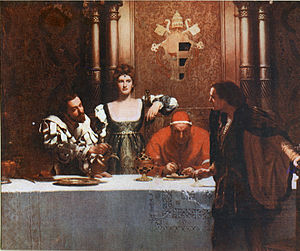The Borgias were a Spanish-Italian noble family that rose to prominence during the Italian Renaissance. They were known for their ambition, ruthlessness, and patronage of the arts.
In 1492 Rodrigo Borgia became Pope Alexander VI, his election to the papacy coming about largely through bribery. The new Pope was a wily, morally corrupt politician, whose love of woman was legendary. Many doubted his suitability to be the new head of the church.
Pope Alexander VI fathered several illegitimate children by his mistress Vannozza Cattani, including a daughter called Lucrezia. He arranged two marriages for her when she was 12 and 13 purely to further his own ambitions, then when he’d got what he wanted out of them he arranged the divorces. The late pope had a picture of her made to look like the Virgin Mary painted over the door of his bedroom.
European Christians believed that the European discovery of the New World was divine intervention so that the American pagans could be converted and thereby complete the evangelization of the entire world in order that Christ could return. Even the corrupt Alexander VI got caught up in this wave of evangelistic zeal and he assembled the ambassadors of Europe to exhort them to dispatch missionaries to the newly discovered continent of America. The proposed crusade petered out quietly but the Pope had helped determine the importance of evangelizing the American continent.
In 1503 the controversial Borgia Pope Alexander VI died of the poison he had prepared for his cardinals. Such was the late Pope’s unpopularity that only four prelates attended his the Requiem Mass.
European Christians believed that the European discovery of the New World was divine intervention so that the American pagans could be converted and thereby complete the evangelization of the entire world in order that Christ could return. Even the corrupt Alexander VI got caught up in this wave of evangelistic zeal and he assembled the ambassadors of Europe to exhort them to dispatch missionaries to the newly discovered continent of America. The proposed crusade petered out quietly but the Pope had helped determine the importance of evangelizing the American continent.
In 1503 the controversial Borgia Pope Alexander VI died of the poison he had prepared for his cardinals. Such was the late Pope’s unpopularity that only four prelates attended his the Requiem Mass.
Alexander VI used his position to advance the interests of his family. The year after his father, Pope Alexander VI, had been elected to the papacy, the 17-year-old Cesare Borgia was made a cardinal.
On 17 August 1498, Cesare Borgia became the first person in history to resign the cardinalate to become captain-general of the papacy, campaigning successfully against the city republics of Italy. Ruthless and treacherous in war, he was an able ruler (a model for Machiavelli's The Prince), but his power crumbled on the death of his father.
 |
| Copy of an original contemporary portrait painting of Cesare Borgias by Bartolomeo Veneto |
Michelangelo worked as an architect and engineer for Cesare Borgia from 1502 to 1503. During that time, he designed a number of fortifications, including the fortress of Imola and the citadel of Cesena. He also supervised the construction of several bridges and roads..
The Banquet of Chestnuts was a supper held by Cesare Borgia in the Papal Palace on October 30, 1501 where fifty prostitutes were in attendance for the entertainment of the guests.
Lucrezia Borgia was the illegitimate daughter of Pope Alexander VI . She was married at 12 and again at 13 to further her father's ambitions, both marriages being annulled by him. At 18 she was married again, but her husband was murdered in 1500 on the order of her brother, with whom (as well as with her father) she was said to have committed incest.
Her final marriage was to the Alfonso d'Este, the heir to the duchy of Ferrara. Lucrezia made the court a center of culture and she was a patron of authors and artists such as Ariosto and Titian.
A Glass of Wine with Caesar Borgia, an 1893 painting by John Collier, represents the popular view of the treacherous nature of the Borgias - the implication being that the young man cannot be sure that the wine is not poisoned. The painting below shows from left: Cesare Borgia, Lucrezia Borgia, Pope Alexander VI, and a young man holding an empty glass
A Glass of Wine with Caesar Borgia, an 1893 painting by John Collier, represents the popular view of the treacherous nature of the Borgias - the implication being that the young man cannot be sure that the wine is not poisoned. The painting below shows from left: Cesare Borgia, Lucrezia Borgia, Pope Alexander VI, and a young man holding an empty glass
 |
| A Glass of Wine with Caesar Borgia, |
.jpg)
No comments:
Post a Comment